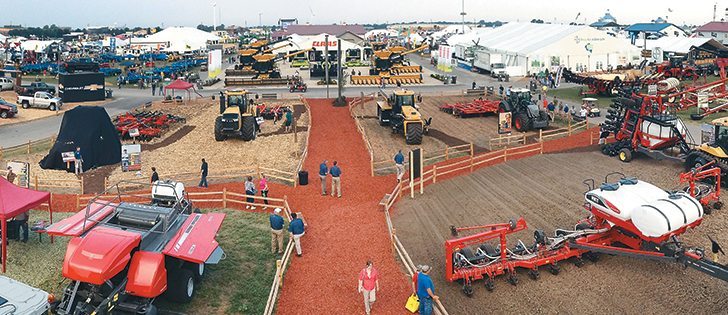Machinery manufacturers have seen sales nosedive but continue to invest in technological improvements and innovative products
DECATUR, Ill. — A soft farm machinery sales year hasn’t slowed the pace of change for farm machinery development.
While staff reductions at some of the industry’s largest companies have been underway for at least three financial quarters, new technology releases remain steady.
Head of Case IH’s agriculture division, Jim Walker, said the company recognizes that farmers are buying fewer large ticket items, but tight margins are making them look for better technology.
“If 2013 hadn’t come along, slowing after 2012 wouldn’t have seemed like such a cliff to fall off of,” said Walker at the Farm Progress Show in Decatur, Illinois.

American Equipment Manufacturers track farm machinery sales and posted a dramatic reduction in Canadian four-wheel drive tractor sales in August.
It showed only seven new machines were sold in July, an 81 percent drop from the same month in 2014.
Sales are also off 28 percent for the year so far. Typically, tractor sales pick up in September and October.
Combine sales were off nine percent for the year so far, with an August reduction of 17 percent year over year.
In the U.S., large four-wheel drive tractor sales have been off 44 percent for the year and 52 for the month of August. Combines are off 31 percent for the year and 39 for August.
A combination of lower commodity prices and an end to the 50 percent, accelerated depreciation taxation allowance on new equipment investment allowed by the U.S. government has cinched tight farmers’ purse strings, according to manufacturers.
Read Also

Equipment manufacturing may return to Canada
Some ag equipment and automotive manufacturers are now adjusting their production and distribution to avoid tariff costs in relation to supplying the Canadian market.
Sales have also been difficult globally. Russian sales are off six percent for four-wheel drive farm tractors and 17 for combines, according to the Russian farm equipment manufacturers’ association, Rosagromasch.
Walker said his company knew the market had to eventually cool and it began to prepare for it a couple years ago.
“But we are here for the long haul. We have to be responsive to our shareholders and remain able to manage a downturn well. This is a cyclical industry, so you don’t damage your operations. You smart-size yourself, keep your (research and development).”
“R and D (investment) for the past seven, more, years has been focused on reducing (diesel engine) emissions. We are at Tier 4 Final now. We are not cutting our research back. We are now able to put more money into innovation and preparing for the eventual upswing in the market,” said Walker.
Travis Becton, who is in charge of John Deere’s marketing for the U.S. and Canada, said despite challenging times “farmers and machinery dealers are looking for innovative products.”
“Consider the world’s current population and where the it’s going to be by 2050, this a great long-term business we are in.”

While the strong U.S. and soft Canadian dollars are offsetting commodity price drops that American producers are experiencing, price increases for farm equipment in Canada are making it harder to sell new machines in Canada.
Colin MacDonald looks after the large tractor segment in North America for John Deere.
“There are several things going on. There is a lot of new iron out there on farms. Establishing a good trade-in value can be tough. The (Canadian) dollar is a challenge. So we have to give farmers some products that will improve their margins enough to make those investments,” he said.
Walker said combines are a good example of how the market has radically changed in a short time. In 2013, North America bought more than 13,700 units. This year, it is estimated that just 7,000 will be sold.
“That is a devastating level.… It is hard to manage that much change, but in agriculture it just part of the business,” said Walker.
He said managing the used inventory has been an issue for farm machinery dealers and has caused farmers to put off buying new machines.
While used combine sales are improving, and high-horsepower and row-crop tractors are moving again, sales of planters, seeders and sprayers are slow.
A few years ago, some of the late-model used inventory was being exported to Eastern Europe and South America, however trade issues, low commodity prices and a high U.S. currency have reduced demand.
Added to that, the Tier 3 and Tier 4 interim emissions systems incompatibility with lower fuel standards in those markets, make late model used machinery less desirable.
Russ Green of Agco said the company is doing well with its new technology sales.
“Farmers are investing in precision agriculture tools. Taking advantage, in many cases, of the newer equipment they have. Trying to find ways of adding some acres on the same (platform). Being more efficient,” he said.
Case IH/New Holland, Deere and Agco all brought new equipment to the market this fall.
New mid-sized tractors, or im-provements to existing lines, and hay and forage machinery took centre stage for the companies as the relative health of the livestock sector has created new opportunities.
Kyle Kitt of Agco introduced a new rear steering feature on the WR9000 windrower, allowing a 25 mph transport speed.
“Livestock and forage producers will be a market, but large grain operations can put a big draper (header) on. They can tow that behind them in transport, again combine-style,” he said.















